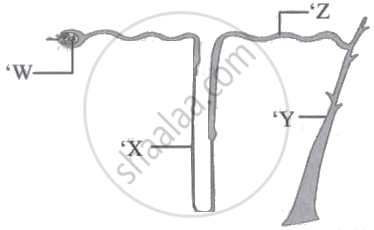Advertisements
Advertisements
प्रश्न
Write the explanation in your words.
Nitya has been admitted to hospital after heavy blood loss. Till proper treatment could be given; how did Nitya's body must have tackled the situation?
उत्तर
- Heavy blood loss is called haemorrhage. In case of haemorrhage or severe dehydration, the osmoreceptors stimulate Antidiuretic hormone (ADH) secretion.
- ADH is important in regulating water balance through the kidneys.
Regulating water reabsorption through ADH:
Hypothalamus in the midbrain has special receptors called osmoreceptors which can detect change in osmolarity (measure of total number of dissolved particles per liter of solution) of blood. If osmolarity of blood increases due to water loss from the body (after eating namkeen or due to sweating), osmoreceptors trigger release of Antidiuretic hormone (ADH) from neurohypophysis (posterior pituitary). ADH stimulates reabsorption of water from last part of DCT and entire collecting duct by increasing the permeability of cells. This leads to reduction in urine volume and decrease in osmolarity of blood. Once the osmolarity of blood comes to normal, activity of osmoreceptor cells decreases leading to decrease in ADH secretion. This is called negative feedback. In case of hemorrhage or severe dehydration too, osmoreceptors stimulate ADH secretion. ADH is important in regulating water balance through kidneys. In absence of ADH, diuresis (dilution of urine) takes place and person tends to excrete large amount of dilute urine. This condition called as diabetes insipidus. - Another regulatory mechanism that must have been activated is RAAS.
Electrolyte reabsorption through RAAS: Another regulatory mechanism is RAAS (Renin Angiotensin Aldosterone System) by Juxta Glomerular Apparatus (JGA). Whenever blood supply (due to change in blood pressure or blood volume) to afferent arteriole decreases (e.g. low BP/dehydration), JGA cells release Renin. Renin converts angiotensinogen secreted by hepatocytes in liver to Angiotensin I. ‘Angiotensin converting enzyme’ further modifies Angiotensin I to Angiotensin II, the active form of hormone. It stimulates adrenal cortex to release another hormone called aldosterone that stimulates DCT and collecting ducts to reabsorb more Na + and water, thereby increasing blood volume and pressure.
APPEARS IN
संबंधित प्रश्न
Osmoreceptors involved in renal control mechanism are found in ____________ part of the brain.
Excess salt intake will lead to ______.
The amount of urine that is excreted everyday by a normal adult is ______.
The ascending limb of the loop of Henle's is lined by ______.
Selective reabsorption by active transport is carried out for substances like ______.
Reabsorption of water does NOT occur in part labelled as

Identify the INCORRECT statement.
The glomerulus filters most of its contents due to hydrostatic pressure created. This pressure is about ____________.
Juxtaglomerular cells secrete ...A... when there is a fall in ...B... ion concentration.
Choose the correct option labelled as A and B.
Renin and angiotensin are secreted by ______ and ______ respectively.
